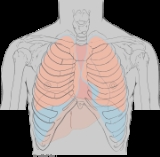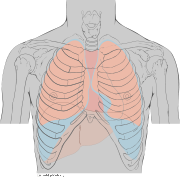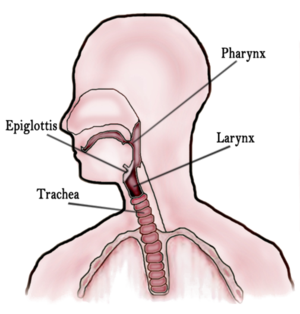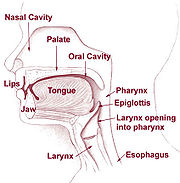
Vocal resonation
Encyclopedia
Vocal resonation is the process by which the basic product of phonation
is enhanced in timbre
and/or intensity by the air-filled cavities through which it passes on its way to the outside air. Various terms related to the resonation process include amplification, enrichment, enlargement, improvement, intensification, and prolongation, although in strictly scientific usage acoustic authorities would question most of them. The main point to be drawn from these terms by a singer or speaker is that the end result of resonation is, or should be, to make a better sound.
There are two basic kinds of resonance: sympathetic resonance (or free resonance) and conductive resonance (or forced resonance). The essential difference between them lies in what causes the resonator to start vibrating. In sympathetic resonance there is no physical contact between the two bodies. The resonator starts functioning because it receives vibrations through the air and responds to them sympathetically. In conductive resonance the resonator starts vibrating because it is in physical contact with a vibrating body.
Both types of resonance are at work in the human voice during speaking and singing. Much of the vibration felt by singers while singing is a result of conductive resonance. The vibrations created by the vocal folds travel along the bones, cartilages, and muscles of the neck, head, and upper chest, causing them to vibrate. There is little evidence that these vibratory sensations make any significant contribution to the external sound.
These same conductive vibrations, however, are good sensation guides for the singer, regardless of their effect on the external sound. These sensations provide evidence to the singer that his vocal folds
are forming strong primary vibrations which are being carried from them to the head and chest. Thus these vibratory sensations can supply sensory feedback about the efficiency of the phonatory process to the singer.
In contrast, the sound a person hears listening to a singer is a product of sympathetic resonance. Vibrations created by the vocal cords travel through air from the larynx
into the cavities of the throat and head, setting them into vibration. This is sympathetic resonance, without physical contact between these cavities and the vocal cords. The vocal resonator is not a sounding board
, comparable with stringed instruments, but rather a column of air, with a shape that is not only complex, but highly variable. Vennard says:
In general, the larger a resonator is, the lower the frequency it will respond to; the greater the volume of air, the lower its pitch. But the pitch also will be affected by the shape of resonator and by the size of opening and amount of lip or neck the resonator has.
A conical shaped resonator, such as a megaphone
, tends to amplify all pitches indiscriminately. A cylindrical shaped resonator is affected primarily by the length of the tube through which the sound wave travels. A spherical resonator will be affected by the amount of opening it has and by whether or not that opening has a lip.
Three factors relating to the walls of a resonator will affect how it functions: the material it is made of, the thickness of its walls, and the type of surface it has, The resonance characteristics of a musical instrument obviously will vary with different materials and the amount of material used will have some effect.
Of special importance to singing is the relationship of the surface of a resonator to its tonal characteristics. Resonators can be highly selective-meaning that they will respond to only one frequency (or multiples of it)-or they can be universal-meaning that they can respond to a broad range of frequencies. In general, the harder the surface of the resonator, the more selective it will be, and the softer the surface, the more universal it will become. "[A] hard resonator will respond only when the vibrator contains an overtone that is exactly in tune with the resonator, while a soft resonator permits a wide range of fundamentals to pass through un-dampened but adds its own frequency as on overtone, harmonic or inharmonic as the case may be."
Hardness carried to the extreme will result in a penetrating tone with a few very strong high partials. Softness carried to the extreme will result in a mushy, non-directional tone of little character. Between these two extremes lies a whole gamut of tonal possibilities.
The final factor to be mentioned is the effect of joining two or more resonators together. In general the effect of joining two or more resonators is that the resonant frequency of each is lowered in different proportions according to their capacities, their orifices, and so forth. The rules governing combined resonators apply to the human voice, for the throat and mouth and sometimes the nose function in this manner.
 There are seven areas that may be listed as possible vocal resonators. In sequence from the lowest within the body to the highest, these areas are the chest, the tracheal tree, the larynx itself, the pharynx, the oral cavity, the nasal cavity, and the sinuses.
There are seven areas that may be listed as possible vocal resonators. In sequence from the lowest within the body to the highest, these areas are the chest, the tracheal tree, the larynx itself, the pharynx, the oral cavity, the nasal cavity, and the sinuses.
and there is nothing in the design of the lungs that could serve to reflect sound waves back toward the larynx
.
 The tracheal tree makes no significant contribution to the resonance system except for a negative effect around its resonant frequency. The trachea
The tracheal tree makes no significant contribution to the resonance system except for a negative effect around its resonant frequency. The trachea
and the bronchial tubes combine to form an inverted Y-shaped structure known as the tracheal tree. It lies just below the larynx
, and, unlike the interior of the lungs, has a definite tubular shape and comparatively hard surfaces. The response of the tracheal tree is the same for all pitches except for its own resonant frequency. When this resonant frequency is reached, the response of the subglottic tube is to act as an acoustical impedance or interference which tends to upset the phonatory function of the larynx
. Research has placed the resonant frequency of the subglottal system or tracheal tree around the E-flat above "middle C" for both men and women, varying somewhat with the size of the individual.
acts as a resonator only for high frequencies. Research indicates that one of the desirable attributes of good vocal tone is a prominent overtone lying between 2800 and 3200 hertz, with male voices nearer the lower limit and female voices nearer the upper. This attribute is identified as brilliance, or more frequently as ring or the singer's formant. There are several areas in or adjacent to the larynx which might resonate such a high pitch. Among them are the collar of the larynx, the ventricles of Morgani, the vallecula, and the pyriform sinuses. The larynx is not under conscious control, but whatever produces "ring" can be encouraged indirectly by awareness on the part of the student and the teacher of the sounds which contain it.
is the most important resonator by virtue of its position, size, and degree of adjustability. It is the first cavity of any size through which the product of the laryngeal vibrator passes; the other supraglottal cavities have to accept whatever the pharynx passes on to them. Greene states:
"The supraglottic resonators being in the main muscular and moveable structures must be voluntarily controlled to produce conditions of optimal resonance either by varying degrees of tension in their walls, or by alterations in the size of their orifices and cavities during the articulatory movements."
 The oral cavity is the second most effective resonator.
The oral cavity is the second most effective resonator.
Phonation
Phonation has slightly different meanings depending on the subfield of phonetics. Among some phoneticians, phonation is the process by which the vocal folds produce certain sounds through quasi-periodic vibration. This is the definition used among those who study laryngeal anatomy and physiology...
is enhanced in timbre
Timbre
In music, timbre is the quality of a musical note or sound or tone that distinguishes different types of sound production, such as voices and musical instruments, such as string instruments, wind instruments, and percussion instruments. The physical characteristics of sound that determine the...
and/or intensity by the air-filled cavities through which it passes on its way to the outside air. Various terms related to the resonation process include amplification, enrichment, enlargement, improvement, intensification, and prolongation, although in strictly scientific usage acoustic authorities would question most of them. The main point to be drawn from these terms by a singer or speaker is that the end result of resonation is, or should be, to make a better sound.
A physiological understanding of resonation
In a technical sense resonance is a relationship that exists between two bodies vibrating at the same frequency or a multiple thereof. In other words, the vibrations emanating from one body cause the other body to start vibrating in tune with it. A resonator may be defined as a secondary vibrator which is set into motion by the main vibrator and which adds its own characteristics to the generated sound waves.There are two basic kinds of resonance: sympathetic resonance (or free resonance) and conductive resonance (or forced resonance). The essential difference between them lies in what causes the resonator to start vibrating. In sympathetic resonance there is no physical contact between the two bodies. The resonator starts functioning because it receives vibrations through the air and responds to them sympathetically. In conductive resonance the resonator starts vibrating because it is in physical contact with a vibrating body.
Both types of resonance are at work in the human voice during speaking and singing. Much of the vibration felt by singers while singing is a result of conductive resonance. The vibrations created by the vocal folds travel along the bones, cartilages, and muscles of the neck, head, and upper chest, causing them to vibrate. There is little evidence that these vibratory sensations make any significant contribution to the external sound.
These same conductive vibrations, however, are good sensation guides for the singer, regardless of their effect on the external sound. These sensations provide evidence to the singer that his vocal folds
Vocal folds
The vocal folds, also known commonly as vocal cords, are composed of twin infoldings of mucous membrane stretched horizontally across the larynx...
are forming strong primary vibrations which are being carried from them to the head and chest. Thus these vibratory sensations can supply sensory feedback about the efficiency of the phonatory process to the singer.
In contrast, the sound a person hears listening to a singer is a product of sympathetic resonance. Vibrations created by the vocal cords travel through air from the larynx
Larynx
The larynx , commonly called the voice box, is an organ in the neck of amphibians, reptiles and mammals involved in breathing, sound production, and protecting the trachea against food aspiration. It manipulates pitch and volume...
into the cavities of the throat and head, setting them into vibration. This is sympathetic resonance, without physical contact between these cavities and the vocal cords. The vocal resonator is not a sounding board
Sounding board
A sound board, or soundboard, is the surface of a string instrument that the strings vibrate against, usually via some sort of bridge. The resonant properties of the sound board and the interior of the instrument greatly increase loudness over the string alone.The sound board operates by the...
, comparable with stringed instruments, but rather a column of air, with a shape that is not only complex, but highly variable. Vennard says:
Factors affecting resonators
There are a number of factors which determine the resonance characteristics of a resonator. Included among them are the following: size, shape, type of opening, composition and thickness of the walls, surface, and combined resonators. The quality of a sound can be appreciably changed by rather small variations in these conditioning factors.In general, the larger a resonator is, the lower the frequency it will respond to; the greater the volume of air, the lower its pitch. But the pitch also will be affected by the shape of resonator and by the size of opening and amount of lip or neck the resonator has.
A conical shaped resonator, such as a megaphone
Megaphone
A megaphone, speaking-trumpet, bullhorn, blowhorn, or loud hailer is a portable, usually hand-held, cone-shaped horn used to amplify a person’s voice or other sounds towards a targeted direction. This is accomplished by channelling the sound through the megaphone, which also serves to match the...
, tends to amplify all pitches indiscriminately. A cylindrical shaped resonator is affected primarily by the length of the tube through which the sound wave travels. A spherical resonator will be affected by the amount of opening it has and by whether or not that opening has a lip.
Three factors relating to the walls of a resonator will affect how it functions: the material it is made of, the thickness of its walls, and the type of surface it has, The resonance characteristics of a musical instrument obviously will vary with different materials and the amount of material used will have some effect.
Of special importance to singing is the relationship of the surface of a resonator to its tonal characteristics. Resonators can be highly selective-meaning that they will respond to only one frequency (or multiples of it)-or they can be universal-meaning that they can respond to a broad range of frequencies. In general, the harder the surface of the resonator, the more selective it will be, and the softer the surface, the more universal it will become. "[A] hard resonator will respond only when the vibrator contains an overtone that is exactly in tune with the resonator, while a soft resonator permits a wide range of fundamentals to pass through un-dampened but adds its own frequency as on overtone, harmonic or inharmonic as the case may be."
Hardness carried to the extreme will result in a penetrating tone with a few very strong high partials. Softness carried to the extreme will result in a mushy, non-directional tone of little character. Between these two extremes lies a whole gamut of tonal possibilities.
The final factor to be mentioned is the effect of joining two or more resonators together. In general the effect of joining two or more resonators is that the resonant frequency of each is lowered in different proportions according to their capacities, their orifices, and so forth. The rules governing combined resonators apply to the human voice, for the throat and mouth and sometimes the nose function in this manner.
The vocal resonators

The chest
The chest is not an effective resonator. Although strong vibratory sensations may be experienced in the upper chest, and although numerous voice books refer to chest resonance, the chest, by virtue of its design and location, can make no significant contribution to the resonance system of the voice. The chest is on the wrong side of the vocal foldsVocal folds
The vocal folds, also known commonly as vocal cords, are composed of twin infoldings of mucous membrane stretched horizontally across the larynx...
and there is nothing in the design of the lungs that could serve to reflect sound waves back toward the larynx
Larynx
The larynx , commonly called the voice box, is an organ in the neck of amphibians, reptiles and mammals involved in breathing, sound production, and protecting the trachea against food aspiration. It manipulates pitch and volume...
.
The tracheal tree

Vertebrate trachea
In tetrapod anatomy the trachea, or windpipe, is a tube that connects the pharynx or larynx to the lungs, allowing the passage of air. It is lined with pseudostratified ciliated columnar epithelium cells with goblet cells that produce mucus...
and the bronchial tubes combine to form an inverted Y-shaped structure known as the tracheal tree. It lies just below the larynx
Larynx
The larynx , commonly called the voice box, is an organ in the neck of amphibians, reptiles and mammals involved in breathing, sound production, and protecting the trachea against food aspiration. It manipulates pitch and volume...
, and, unlike the interior of the lungs, has a definite tubular shape and comparatively hard surfaces. The response of the tracheal tree is the same for all pitches except for its own resonant frequency. When this resonant frequency is reached, the response of the subglottic tube is to act as an acoustical impedance or interference which tends to upset the phonatory function of the larynx
Larynx
The larynx , commonly called the voice box, is an organ in the neck of amphibians, reptiles and mammals involved in breathing, sound production, and protecting the trachea against food aspiration. It manipulates pitch and volume...
. Research has placed the resonant frequency of the subglottal system or tracheal tree around the E-flat above "middle C" for both men and women, varying somewhat with the size of the individual.
The larynx
Due to its small size, the larynxLarynx
The larynx , commonly called the voice box, is an organ in the neck of amphibians, reptiles and mammals involved in breathing, sound production, and protecting the trachea against food aspiration. It manipulates pitch and volume...
acts as a resonator only for high frequencies. Research indicates that one of the desirable attributes of good vocal tone is a prominent overtone lying between 2800 and 3200 hertz, with male voices nearer the lower limit and female voices nearer the upper. This attribute is identified as brilliance, or more frequently as ring or the singer's formant. There are several areas in or adjacent to the larynx which might resonate such a high pitch. Among them are the collar of the larynx, the ventricles of Morgani, the vallecula, and the pyriform sinuses. The larynx is not under conscious control, but whatever produces "ring" can be encouraged indirectly by awareness on the part of the student and the teacher of the sounds which contain it.
The pharynx
The pharynxPharynx
The human pharynx is the part of the throat situated immediately posterior to the mouth and nasal cavity, and anterior to the esophagus and larynx. The human pharynx is conventionally divided into three sections: the nasopharynx , the oropharynx , and the laryngopharynx...
is the most important resonator by virtue of its position, size, and degree of adjustability. It is the first cavity of any size through which the product of the laryngeal vibrator passes; the other supraglottal cavities have to accept whatever the pharynx passes on to them. Greene states:
"The supraglottic resonators being in the main muscular and moveable structures must be voluntarily controlled to produce conditions of optimal resonance either by varying degrees of tension in their walls, or by alterations in the size of their orifices and cavities during the articulatory movements."
The oral cavity


